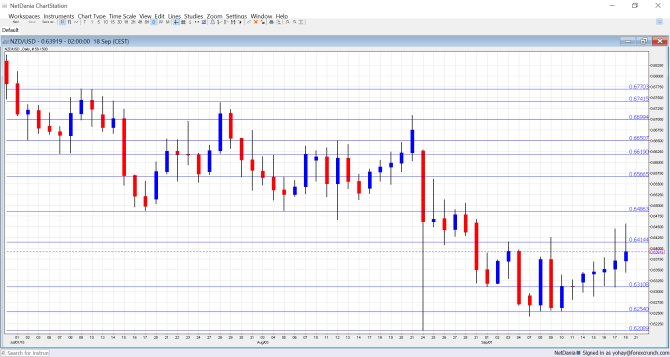The New Zealand dollar managed to stage a recovery, but this was short lived. Here is an analysis of fundamentals and an updated technical analysis for NZD/USD.
The price of milk extended its recovery, with the GDT Price Index jumping by 16.5%. However, GDT went in the opposite direction to GDP, which advanced by only 0.4% and implies further rate cuts. In the US, the Fed refrained from hiking and its worries about the global economy eventually triggered the question: which bank goes next? The kiwi had its time in the sun, but this didn’t go too far.
[do action=”autoupdate” tag=”NZDUSDUpdate”/]NZD/USD daily graph with support and resistance lines on it. Click to enlarge:
- Westpac Consumer Sentiment: Sunday, 10:00. This quarterly measure of confidence dropped in Q1 to 113 points, the lowest since 2013. Another drop is on the cards for Q2.
- Visitor Arrivals: Sunday, 22:45. Tourism also plays an important role in the economy of New Zealand. After a fall of 2.7% in July, some stabilization is on the cards for August.
- Credit Card Spending: Monday, 3:00. With retail sales published only once every quarter, this spending barometer measures the kiwi consumer. A y/y rise of 9.7% was seen in July, so some moderation might be recorded in August.
- Trade Balance: Wednesday, 22:45. After a few months of surpluses, New Zealand’s balance of trade went back into the red. It is now expected to deepen from a deficit of 649 million to 875 million.
NZD/USD Technical Analysis
Kiwi/dollar started off the week with some gains, and these intensified. While the pair lost a lot of ground in the last moment, it eventually found support above 0.6310 (mentioned last week).
Live chart of NZD/USD:
[do action=”tradingviews” pair=”NZDUSD” interval=”60″/]Technical lines, from top to bottom:
We begin from lower ground this week. Yhe low of 0.6940 allowed for a temporary bounce. The round 0.69 level is switched positions to resistance.
0.6860 was a low point as the pair dropped in June 2015. It is followed by the 0.68 level that worked as resistance when the pair was climbing a few years back.
Close by, the July high of 0.6770 serves as resistance. Quite close by, the high of 0.6740 seen in July is another cap.
It is followed by the round level of 0.67 that is a pivotal line in the range. The now previous July low of 0.6650 was a multi-year low and the break below it was not confirmed.
0.6620 is the new 2015 low and for now serves as minor support. The post crisis low of 0.6560 is still of high importance.
Below, the round 0.65 level is of high importance now. The last line is 0.64886, which was the low both in July and in August – a double bottom.
The new post crash low of 0.6408 works as important support within the recent range. Below, 0.6310 provides some support after doing so in early September.
0.6255 seems to be a line of stabilization as seen in September after the second blow down. 0.6210 is the flash crash low. It is followed by 0.6160 that can be noted as a post crisis attempt to recover.
I remain bearish on NZD/USD
There are few reasons to be cheerful about New Zealand, with a slowing economy and less Chinese demand. The Fed’s worries, as reflected in Yellen’s appearance, mean that the RBNZ is likely to cut rates once again quite soon.
In our latest podcast we explain why the dollar defies the doves
Further reading:
- For a broad view of all the week’s major events worldwide, read the USD outlook.
- For EUR/USD, check out the Euro to Dollar forecast.
- For the Japanese yen, read the USD/JPY forecast.
- For GBP/USD (cable), look into the British Pound forecast.
- For the Australian dollar (Aussie), check out the AUD to USD forecast.
- For USD/CAD (loonie), check out the Canadian dollar forecast.

